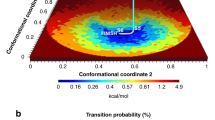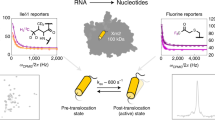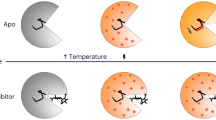Abstract
RNAs fold into three-dimensional (3D) structures that subsequently undergo large, functionally important, conformational transitions in response to a variety of cellular signals1,2,3. RNA structures are believed to encode spatially tuned flexibility that can direct transitions along specific conformational pathways4,5. However, this hypothesis has proved difficult to examine directly because atomic movements in complex biomolecules cannot be visualized in 3D by using current experimental methods. Here we report the successful implementation of a strategy using NMR that has allowed us to visualize, with complete 3D rotational sensitivity, the dynamics between two RNA helices that are linked by a functionally important trinucleotide bulge over timescales extending up to milliseconds. The key to our approach is to anchor NMR frames of reference onto each helix and thereby directly measure their dynamics, one relative to the other, using ‘relativistic’ sets of residual dipolar couplings (RDCs)6,7. Using this approach, we uncovered super-large amplitude helix motions that trace out a surprisingly structured and spatially correlated 3D dynamic trajectory. The two helices twist around their individual axes by approximately 53° and 110° in a highly correlated manner (R = 0.97) while simultaneously (R = 0.81–0.92) bending by about 94°. Remarkably, the 3D dynamic trajectory is dotted at various positions by seven distinct ligand-bound conformations of the RNA. Thus even partly unstructured RNAs can undergo structured dynamics that directs ligand-induced transitions along specific predefined conformational pathways.
This is a preview of subscription content, access via your institution
Access options
Subscribe to this journal
Receive 51 print issues and online access
$199.00 per year
only $3.90 per issue
Buy this article
- Purchase on Springer Link
- Instant access to full article PDF
Prices may be subject to local taxes which are calculated during checkout




Similar content being viewed by others
References
Micura, R. & Hobartner, C. On secondary structure rearrangements and equilibria of small RNAs. ChemBioChem 4, 984–990 (2003)
Schroeder, R., Barta, A. & Semrad, K. Strategies for RNA folding and assembly. Nature Rev. Mol. Cell Biol. 5, 908–919 (2004)
Schwalbe, H. et al. Structures of RNA switches: insight into molecular recognition and tertiary structure. Angew. Chem. Int. Edn Engl. 46, 1212–1219 (2007)
Leulliot, N. & Varani, G. Current topics in RNA-protein recognition: control of specificity and biological function through induced fit and conformational capture. Biochemistry 40, 7947–7956 (2001)
Al-Hashimi, H. M. Dynamics-based amplification of RNA function and its characterization by using NMR spectroscopy. ChemBioChem 6, 1506–1519 (2005)
Tjandra, N. & Bax, A. Direct measurement of distances and angles in biomolecules by NMR in a dilute liquid crystalline medium. Science 278, 1111–1114 (1997)
Tolman, J. R., Flanagan, J. M., Kennedy, M. A. & Prestegard, J. H. NMR evidence for slow collective motions in cyanometmyoglobin. Nature Struct. Biol. 4, 292–297 (1997)
Furtig, B. et al. Time-resolved NMR studies of RNA folding. Biopolymers 86, 360–383 (2007)
Blackledge, M. Recent progress in the study of biomolecular structure and dynamics in solution from residual dipolar couplings. Prog. Nucl. Magn. Reson. Spectrosc. 46, 23–61 (2005)
Mittermaier, A. & Kay, L. E. New tools provide new insights in NMR studies of protein dynamics. Science 312, 224–228 (2006)
Palmer, A. G. & Massi, F. Characterization of the dynamics of biomacromolecules using rotating-frame spin relaxation NMR spectroscopy. Chem. Rev. 106, 1700–1719 (2006)
Bruschweiler, R. New approaches to the dynamic interpretation and prediction of NMR relaxation data from proteins. Curr. Opin. Struct. Biol. 13, 175–183 (2003)
Zhang, Q., Sun, X., Watt, E. D. & Al-Hashimi, H. M. Resolving the motional modes that code for RNA adaptation. Science 311, 653–656 (2006)
Zhang, Q. & Al-Hashimi, H. M. Extending the NMR spatial resolution limit by motional couplings. Nature Methods (submitted)
Aboul-ela, F., Karn, J. & Varani, G. Structure of HIV-1 TAR RNA in the absence of ligands reveals a novel conformation of the trinucleotide bulge. Nucleic Acids Res. 24, 3974–3981 (1996)
Puglisi, J. D. et al. Conformation of the TAR RNA-arginine complex by NMR spectroscopy. Science 257, 76–80 (1992)
Aboul-ela, F., Karn, J. & Varani, G. The structure of the human-immunodeficiency-virus type-1 Tar RNA reveals principles of RNA recognition by Tat protein. J. Mol. Biol. 253, 313–332 (1995)
Ippolito, J. A. & Steitz, T. A. A 1.3-angstrom resolution crystal structure of the HIV-1 trans- activation response region RNA stem reveals a metal ion- dependent bulge conformation. Proc. Natl Acad. Sci. USA 95, 9819–9824 (1998)
Faber, C., Sticht, H., Schweimer, K. & Rosch, P. Structural rearrangements of HIV-1 Tat-responsive RNA upon binding of neomycin B. J. Biol. Chem. 275, 20660–20666 (2000)
Du, Z., Lind, K. E. & James, T. L. Structure of TAR RNA complexed with a Tat–TAR interaction nanomolar inhibitor that was identified by computational screening. Chem. Biol. 9, 707–712 (2002)
Davis, B. et al. Rational design of inhibitors of HIV-1 TAR RNA through the stabilisation of electrostatic ‘hot spots’. J. Mol. Biol. 336, 343–356 (2004)
Murchie, A. I. et al. Structure-based drug design targeting an inactive RNA conformation: exploiting the flexibility of HIV-1 TAR RNA. J. Mol. Biol. 336, 625–638 (2004)
Hansen, M. R., Mueller, L. & Pardi, A. Tunable alignment of macromolecules by filamentous phage yields dipolar coupling interactions. Nature Struct. Biol. 5, 1065–1074 (1998)
Meiler, J. et al. Model-free approach to the dynamic interpretation of residual dipolar couplings in globular proteins. J. Am. Chem. Soc. 123, 6098–6107 (2001)
Tolman, J. R., Al-Hashimi, H. M., Kay, L. E. & Prestegard, J. H. Structural and dynamic analysis of residual dipolar coupling data for proteins. J. Am. Chem. Soc. 123, 1416–1424 (2001)
Musselman, C. et al. Impact of static and dynamic A-form heterogeneity on the determination of RNA global structural dynamics using NMR residual dipolar couplings. J. Biomol. NMR 36, 235–249 (2006)
Saupe, A. Recent results in the field of liquid crystals. Angew. Chem. Int. Edn Engl. 7, 97–112 (1968)
Clore, G. M. & Schwieters, C. D. Amplitudes of protein backbone dynamics and correlated motions in a small alpha/beta protein: correspondence of dipolar coupling and heteronuclear relaxation measurements. Biochemistry 43, 10678–10691 (2004)
Al-Hashimi, H. M. et al. Concerted motions in HIV-1 TAR RNA may allow access to bound state conformations: RNA dynamics from NMR residual dipolar couplings. J. Mol. Biol. 315, 95–102 (2002)
Meissner, A. & Sorensen, O. W. The role of coherence transfer efficiency in design of TROSY- type multidimensional NMR experiments. J. Magn. Reson. 139, 439–442 (1999)
Cornilescu, G., Marquardt, J. L., Ottiger, M. & Bax, A. Validation of protein structure from anisotropic carbonyl chemical shifts in a dilute liquid crystalline phase. J. Am. Chem. Soc. 120, 6836–6837 (1998)
Bailor, M. H. et al. Characterizing the relative orientation and dynamics of RNA A-form helices using NMR residual dipolar couplings. Nature Protoc. 2, 1536–1546 (2007)
Saenger, W. Principles of Nucleic Acid Structure (Springer-Verlag, New York, New York, 1984)
Zweckstetter, M. & Bax, A. Prediction of sterically induced alignment in a dilute liquid crystalline phase; aid to protein structure determination by NMR. J. Am. Chem. Soc. 122, 3791–3792 (2000)
Clore, G. M. et al. Deviations from the simple two-parameter model-free approach to the interpretation of nitrogen-15 nuclear magnetic relaxation of proteins. J. Am. Chem. Soc. 112, 4989–4991 (1990)
Mandel, A. M., Akke, M. & Palmer, A. G. Backbone dynamics of Escherichia coli ribonuclease Hi: correlations with structure and function in an active enzyme. J. Mol. Biol. 246, 144–163 (1995)
Acknowledgements
We thank A. Kurochkin for NMR expertise. We acknowledge the Michigan Economic Development Cooperation and the Michigan Technology Tri-Corridor for the support of the purchase of a 600 MHz spectrometer, and the W. F. Keck Foundation, National Science Foundation (NSF) and National Institutes of Health (NIH) for funds for the purchase of an 800 MHz spectrometer. Supported by an NIH and NSF grant.
Author Contributions H.M.A. conceived the technique, Q.Z. and H.M.A. analysed the data and wrote the paper. Q.Z., C.K.F. and H.M.A. analysed the HIV-2 TAR data. Q.Z., A.C.S. and C.K.F. prepared the samples and performed the NMR experiments.
Author information
Authors and Affiliations
Corresponding author
Additional information
Supplementary Movies are hosted at the publicly accessible Database of Macromolecular Movements (http://www.molmovdb.org/).
Supplementary information
Supplementary Information
This file contains Supplementary Discussion; Supplementary Tables S1-S4; Supplementary Figures S1-S5 with Legends; Legends to Supplementary Movies 1-2; and additional references. (PDF 3655 kb)
Supplementary Movie 1
This file contains Supplementary Movie 1 showing the TAR inter-helix motional trajectory. Shown are transitions 1→2, 2→3, and 3→1 between conformers in ensemble A via the linear conformational pathway in 3D inter-helix Euler space (see green lines in Fig. 4a of the main manuscript). HI and HII are shown in black and orange and are elongated in gray for clarity. (MOV 2411 kb)
Supplementary Movie 2
This file contains Supplementary Movie 2 showing how the TAR inter-helix motional trajectory encapsulates ligand-bound conformations. The TAR inter-helical motional trajectory is shown (in green) together with the ligand bound TAR conformations (in gray). Helix HI was used to superimpose all structures, which are represented using idealized A-form helices. (MOV 10611 kb)
Rights and permissions
About this article
Cite this article
Zhang, Q., Stelzer, A., Fisher, C. et al. Visualizing spatially correlated dynamics that directs RNA conformational transitions. Nature 450, 1263–1267 (2007). https://doi.org/10.1038/nature06389
Received:
Accepted:
Issue Date:
DOI: https://doi.org/10.1038/nature06389
This article is cited by
-
Observation of structural switch in nascent SAM-VI riboswitch during transcription at single-nucleotide and single-molecule resolution
Nature Communications (2023)
-
Rapid and accurate determination of atomistic RNA dynamic ensemble models using NMR and structure prediction
Nature Communications (2020)
-
The roles of structural dynamics in the cellular functions of RNAs
Nature Reviews Molecular Cell Biology (2019)
-
Maximizing accuracy of RNA structure in refinement against residual dipolar couplings
Journal of Biomolecular NMR (2019)
-
Synthesis and applications of RNAs with position-selective labelling and mosaic composition
Nature (2015)
Comments
By submitting a comment you agree to abide by our Terms and Community Guidelines. If you find something abusive or that does not comply with our terms or guidelines please flag it as inappropriate.



